I’m sure you’ve noticed, like I have, that people are compulsively titling their beaver talks or columns with catchy philosophical labels like “Beaver: Eco-savior OR rodent pest” “Beaver: Boon or Bastard?” “Beaver: Helps or Harasses?” I’m putting the world on notice to say RIGHT now that it needs to STOP. Every single one of those titles and the millions more out there are misleading and false. They all contain a single word that is as untrue as anything you can read. And for this reason they should be stopped.
You know what wickedly misleading word, right I’m talking about, right?
Obviously a beaver is a nuisance AND a friend, a boon AND a bastard, a worry AND a wonder. They can be both, (and really can’t we all?) Even though our impulse is to reduce things to simple single quality and ignore all the other information, the only way we can TRULY understand beavers is to see that they are honestly both. They make the habitat enormously better and screw up your culvert or your farm at the same time. Just as the mature man recognizes their is good and evil within every person, we have to deal head-on with the beaver’s duality and start from there. The difference of course is that, unlike man, with beavers it’s the very same action they take that is both burdensome and beneficial. I was reminded of this by this article yesterday from the Elk River Alliance in British Columbia.
Beavers are more than Canada’s national symbol and our first national currency trading their pelts. They are also wetland engineers. Just look upstream of the north-Fernie bridge, along the Elk River and you will see an incredible dam built this summer. Although cute industrious critters, are beavers actually friend or foe to Canadians?
 While these busy rodents amaze many people, others are less impressed and more annoyed by their activity. Beavers fell trees and their dams can, in some instances, flood property that people might prefer to keep dry. So what good are they to us anyway?
While these busy rodents amaze many people, others are less impressed and more annoyed by their activity. Beavers fell trees and their dams can, in some instances, flood property that people might prefer to keep dry. So what good are they to us anyway?
The beaver is a semi-aquatic herbivore that cuts down trees to eat the branches and chew off the bark. They also use this material to build dams and lodges, modifying their environment like us, making them a very unique species. Beavers build dams in order to back up water creating a deep pool of water surrounding their home, especially the entrance. This is important, even during times of low water, as exposure poses a security threat to their den. If water levels are low and the entrance exposed, there is a greater risk of predation to the beaver family.
Rising water levels behind dams may be a nuisance to us but have you considered that this water also creates rich and vibrant wetlands, home to an array of different species, increasing the biodiversity and productivity of our watershed. For free, wetland plants filter out toxins and unwanted chemicals, as well as sediment before water flows back into the Elk River, improving water quality.
Beaver dams also increase water storage capacity in our watershed, both above and below ground. They store increased surface water and are capable of raising the ground water table, important in mitigating the effects of drought. Furthermore, beaver dams help reduce the speed and power of moving water, limiting its erosive capacity and allowing more storage, thus buffering flood damage.
below ground. They store increased surface water and are capable of raising the ground water table, important in mitigating the effects of drought. Furthermore, beaver dams help reduce the speed and power of moving water, limiting its erosive capacity and allowing more storage, thus buffering flood damage.
These key functions benefit both the watershed and Canada’s largest rodent. This is why community members, local government, small businesses, and Elk River Alliance joined forces to mitigate the potential damaging affects of beavers in Fernie. Together they installed two large, pond-leveling devices to reduce negative effects of increased surface water: one in the West Fernie wetland and the second one at the McDougal Wetland north of Maiden Lake.
Thank goodness the article is better than the title, because it goes on to describe how the Elk River Alliance learned how to install two flow devices and taught these skills to some other players in Canada. Because the smart answer is that beavers are BOTH a friend and a foe,. Our job, if we want to get the ‘friend’ benefits, is to solve the ‘foe’ challenges correctly!
I received lots of notices about this article yesterday so I know it’s getting it’s attention. I also got a response from Nathaniel at Parks Canada who thanked me for the information I sent on a real beaver deceiver and said they were considering their options. Maybe this article even crossed his desk too? Let’s hope beavers keep moving in the right direction with fewer false dichotomies!
Must it all be either less or more,
Either plain or grand?
Is it always ‘or’?
Is it never ‘and’?
Stephen Sondheim






































